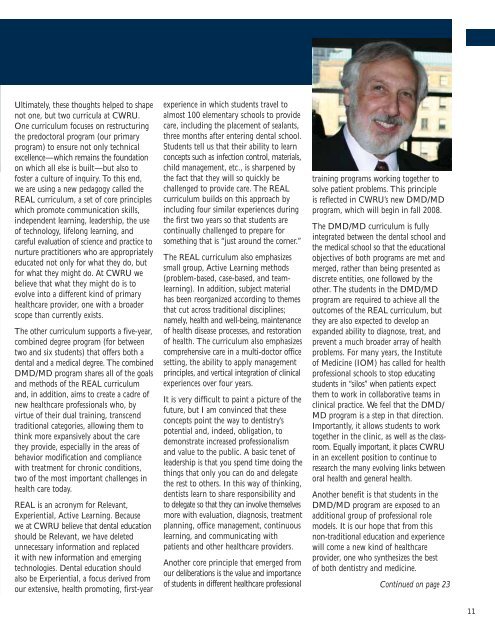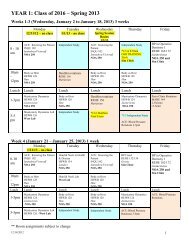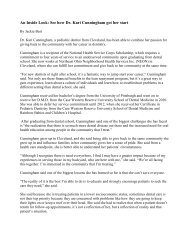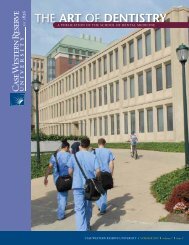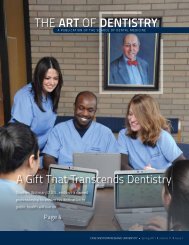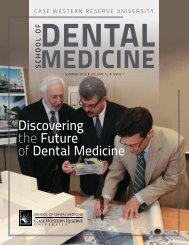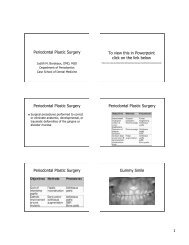THE ART OF DENTISTRY - School of Dental Medicine - Case ...
THE ART OF DENTISTRY - School of Dental Medicine - Case ...
THE ART OF DENTISTRY - School of Dental Medicine - Case ...
Create successful ePaper yourself
Turn your PDF publications into a flip-book with our unique Google optimized e-Paper software.
Ultimately, these thoughts helped to shape<br />
not one, but two curricula at CWRU.<br />
One curriculum focuses on restructuring<br />
the predoctoral program (our primary<br />
program) to ensure not only technical<br />
excellence—which remains the foundation<br />
on which all else is built—but also to<br />
foster a culture <strong>of</strong> inquiry. To this end,<br />
we are using a new pedagogy called the<br />
REAL curriculum, a set <strong>of</strong> core principles<br />
which promote communication skills,<br />
independent learning, leadership, the use<br />
<strong>of</strong> technology, lifelong learning, and<br />
careful evaluation <strong>of</strong> science and practice to<br />
nurture practitioners who are appropriately<br />
educated not only for what they do, but<br />
for what they might do. At CWRU we<br />
believe that what they might do is to<br />
evolve into a different kind <strong>of</strong> primary<br />
healthcare provider, one with a broader<br />
scope than currently exists.<br />
The other curriculum supports a five-year,<br />
combined degree program (for between<br />
two and six students) that <strong>of</strong>fers both a<br />
dental and a medical degree. The combined<br />
DMD/MD program shares all <strong>of</strong> the goals<br />
and methods <strong>of</strong> the REAL curriculum<br />
and, in addition, aims to create a cadre <strong>of</strong><br />
new healthcare pr<strong>of</strong>essionals who, by<br />
virtue <strong>of</strong> their dual training, transcend<br />
traditional categories, allowing them to<br />
think more expansively about the care<br />
they provide, especially in the areas <strong>of</strong><br />
behavior modification and compliance<br />
with treatment for chronic conditions,<br />
two <strong>of</strong> the most important challenges in<br />
health care today.<br />
REAL is an acronym for Relevant,<br />
Experiential, Active Learning. Because<br />
we at CWRU believe that dental education<br />
should be Relevant, we have deleted<br />
unnecessary information and replaced<br />
it with new information and emerging<br />
technologies. <strong>Dental</strong> education should<br />
also be Experiential, a focus derived from<br />
our extensive, health promoting, first-year<br />
experience in which students travel to<br />
almost 100 elementary schools to provide<br />
care, including the placement <strong>of</strong> sealants,<br />
three months after entering dental school.<br />
Students tell us that their ability to learn<br />
concepts such as infection control, materials,<br />
child management, etc., is sharpened by<br />
the fact that they will so quickly be<br />
challenged to provide care. The REAL<br />
curriculum builds on this approach by<br />
including four similar experiences during<br />
the first two years so that students are<br />
continually challenged to prepare for<br />
something that is “just around the corner.”<br />
The REAL curriculum also emphasizes<br />
small group, Active Learning methods<br />
(problem-based, case-based, and teamlearning).<br />
In addition, subject material<br />
has been reorganized according to themes<br />
that cut across traditional disciplines;<br />
namely, health and well-being, maintenance<br />
<strong>of</strong> health disease processes, and restoration<br />
<strong>of</strong> health. The curriculum also emphasizes<br />
comprehensive care in a multi-doctor <strong>of</strong>fice<br />
setting, the ability to apply management<br />
principles, and vertical integration <strong>of</strong> clinical<br />
experiences over four years.<br />
It is very difficult to paint a picture <strong>of</strong> the<br />
future, but I am convinced that these<br />
concepts point the way to dentistry’s<br />
potential and, indeed, obligation, to<br />
demonstrate increased pr<strong>of</strong>essionalism<br />
and value to the public. A basic tenet <strong>of</strong><br />
leadership is that you spend time doing the<br />
things that only you can do and delegate<br />
the rest to others. In this way <strong>of</strong> thinking,<br />
dentists learn to share responsibility and<br />
to delegate so that they can involve themselves<br />
more with evaluation, diagnosis, treatment<br />
planning, <strong>of</strong>fice management, continuous<br />
learning, and communicating with<br />
patients and other healthcare providers.<br />
Another core principle that emerged from<br />
our deliberations is the value and importance<br />
<strong>of</strong> students in different healthcare pr<strong>of</strong>essional<br />
training programs working together to<br />
solve patient problems. This principle<br />
is reflected in CWRU’s new DMD/MD<br />
program, which will begin in fall 2008.<br />
The DMD/MD curriculum is fully<br />
integrated between the dental school and<br />
the medical school so that the educational<br />
objectives <strong>of</strong> both programs are met and<br />
merged, rather than being presented as<br />
discrete entities, one followed by the<br />
other. The students in the DMD/MD<br />
program are required to achieve all the<br />
outcomes <strong>of</strong> the REAL curriculum, but<br />
they are also expected to develop an<br />
expanded ability to diagnose, treat, and<br />
prevent a much broader array <strong>of</strong> health<br />
problems. For many years, the Institute<br />
<strong>of</strong> <strong>Medicine</strong> (IOM) has called for health<br />
pr<strong>of</strong>essional schools to stop educating<br />
students in “silos” when patients expect<br />
them to work in collaborative teams in<br />
clinical practice. We feel that the DMD/<br />
MD program is a step in that direction.<br />
Importantly, it allows students to work<br />
together in the clinic, as well as the classroom.<br />
Equally important, it places CWRU<br />
in an excellent position to continue to<br />
research the many evolving links between<br />
oral health and general health.<br />
Another benefit is that students in the<br />
DMD/MD program are exposed to an<br />
additional group <strong>of</strong> pr<strong>of</strong>essional role<br />
models. It is our hope that from this<br />
non-traditional education and experience<br />
will come a new kind <strong>of</strong> healthcare<br />
provider, one who synthesizes the best<br />
<strong>of</strong> both dentistry and medicine.<br />
Continued on page 23<br />
11


